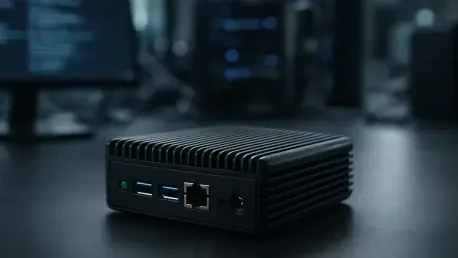In an era where data fuels every aspect of modern life, the deployment of Artificial Intelligence (AI) is undergoing a profound shift that promises to reshape how technology interacts with the world, moving from centralized cloud servers to the source of data generation through Edge AI and distributed computing. This transition is far more than a mere adjustment in infrastructure; it represents a groundbreaking reimagining of intelligence itself, enabling faster decision-making, bolstering privacy, and reducing dependency on distant data hubs. Edge AI empowers devices such as smartphones, industrial sensors, and autonomous vehicles to process information locally, delivering real-time insights without the lag associated with cloud communication. Meanwhile, distributed computing scatters AI workloads across interconnected networks, fostering collaboration while safeguarding sensitive data. Together, these innovations confront the longstanding issues of latency, bandwidth constraints, and security risks inherent in cloud-centric models. The implications are vast, touching everything from urban infrastructure to personal gadgets, and heralding a future where intelligence is seamlessly woven into the physical environment. Yet, as this transformation unfolds, it brings with it complex challenges that demand attention. Exploring the dimensions of this shift reveals not only its potential to revolutionize industries but also the hurdles that must be navigated to fully harness its power.
Breaking Away from Centralization
The pivot from centralized cloud-based AI to decentralized processing marks a critical response to the growing demands for speed and data protection in today’s tech landscape. Edge AI stands at the forefront of this change, enabling devices to handle data analysis directly where it’s generated, thus slashing the delays that occur when information must travel to remote servers. This capability proves indispensable in scenarios where timing is everything—think of an autonomous vehicle navigating a busy intersection, where even a millisecond of latency could lead to disaster. By processing data on-site, Edge AI ensures that decisions are made instantaneously, enhancing both safety and efficiency across a range of applications.
Complementing this localized approach, distributed computing introduces a framework where AI tasks are shared across multiple devices or nodes, eliminating the need for a singular control center. This structure not only scales effortlessly to handle growing data volumes but also prioritizes privacy by keeping raw information on the originating device rather than transmitting it across vulnerable networks. The synergy of these two paradigms creates an AI ecosystem that’s not just reactive but inherently more secure and adaptable. It’s a system designed to meet the needs of a world where connectivity is ubiquitous, and the expectation for immediate, reliable responses is non-negotiable. This decentralized model fundamentally alters how intelligence operates, bringing it closer to the point of action and setting a new standard for technological responsiveness.
Powering the Edge with Cutting-Edge Hardware
Underpinning the rise of Edge AI is a surge of hardware innovations specifically engineered to meet the demands of compact, resource-limited environments. Specialized processors such as Neural Processing Units (NPUs), advanced Graphics Processing Units (GPUs), and tailored Application-Specific Integrated Circuits (ASICs) are redefining what’s possible on small devices. These components are meticulously designed to execute complex AI computations with minimal power draw, addressing the critical challenge of maintaining performance without draining batteries or overheating. Their ability to balance high computational output with energy efficiency makes them the backbone of intelligent edge devices, from wearable tech to industrial machinery.
The race to develop these advanced chips is heating up, with both established tech giants and agile startups pushing the boundaries of innovation. This competitive drive is accelerating the evolution of hardware capable of supporting sophisticated AI tasks in environments previously deemed too constrained for such processing. Beyond just enabling functionality, these advancements are expanding the scope of where AI can be applied, embedding intelligence into the smallest of devices without sacrificing capability. As this hardware continues to evolve, it paves the way for broader adoption of Edge AI, ensuring that even the most modest gadgets can contribute to a smarter, more connected world. The impact of these developments is profound, as they lay the technical foundation for a future where intelligence is not confined to data centers but thrives at the network’s periphery.
Software Architectures for a Distributed Future
While hardware provides the raw power for Edge AI, software architectures are equally vital in orchestrating decentralized intelligence across diverse systems. One standout approach, Federated Learning, enables devices to collaboratively train AI models without ever exchanging raw data, thus preserving user privacy while still benefiting from collective insights. This method allows a network of devices—whether smartphones or IoT sensors—to refine algorithms locally and share only the resulting updates, ensuring sensitive information remains secure. It’s a powerful solution for industries like healthcare, where data confidentiality is paramount, yet collective learning can drive significant advancements.
Equally important are techniques like data and model parallelism, which distribute computational workloads across multiple systems to enhance scalability and efficiency. These methods address the inherent complexities of managing AI in decentralized environments, ensuring that tasks are processed effectively even when resources vary widely among devices. Such software frameworks provide the flexibility needed to adapt to different contexts, from sprawling industrial networks to personal consumer gadgets. By enabling seamless collaboration and resource sharing, these architectures ensure that distributed AI remains robust and responsive, no matter the scale or diversity of the network. This software evolution is critical, as it bridges the gap between localized processing and global connectivity, crafting a cohesive ecosystem where intelligence can flourish beyond traditional boundaries.
Reshaping the Tech Industry Landscape
The emergence of Edge AI and distributed computing is sending ripples through the technology sector, fundamentally altering competitive dynamics among industry players. Major corporations, long dominant in cloud computing, are now extending their reach into edge environments, crafting integrated solutions that span both centralized and localized processing. This strategic pivot reflects a recognition that future growth lies in offering seamless experiences across diverse platforms, blending the strengths of cloud scalability with the immediacy of edge intelligence. The result is a marketplace where adaptability and integration are becoming essential for maintaining relevance.
Simultaneously, chipmakers are fueling this transformation by innovating energy-efficient processors tailored for edge applications, while nimble startups seize opportunities to develop specialized tools and platforms. This competitive environment is fostering the rise of full-stack AI solutions, where hardware and software are bundled into cohesive offerings that cater to specific needs. Such a shift challenges traditional cloud providers to rethink their models, as the emphasis moves toward localized processing and networked collaboration. The industry is witnessing a redefinition of value, with companies that can deliver end-to-end solutions gaining an edge. This evolving landscape underscores a broader trend: the future of tech lies in balancing centralized power with decentralized agility, creating a dynamic interplay that will shape innovation for years to come.
Embedding Intelligence into Everyday Life
On a societal level, Edge AI and distributed computing are ushering in an age of ubiquitous intelligence, seamlessly integrating AI into the fabric of daily existence. In healthcare, for instance, edge devices enable real-time diagnostics, allowing wearable monitors to detect anomalies and alert medical professionals instantly, potentially saving lives. Similarly, in transportation, autonomous vehicles depend on immediate data processing at the edge to navigate complex environments safely, avoiding obstacles without waiting for cloud input. Smart cities, too, benefit from distributed systems that optimize traffic flow and energy usage, enhancing urban efficiency through interconnected sensors and devices.
The advantages of this pervasive intelligence are manifold, spanning faster response times, heightened privacy through local data handling, and reduced bandwidth costs by minimizing data transmission. However, these benefits come with notable challenges, including heightened security risks due to the expanded attack surface of distributed networks and the logistical difficulties of managing countless decentralized systems. Addressing these issues requires robust safeguards and streamlined orchestration to ensure reliability across varied applications. The societal impact of this technological shift is transformative, promising to enhance quality of life through smarter environments, yet it demands careful navigation of the complexities involved. Balancing innovation with accountability will be key to unlocking the full potential of AI embedded in the world around us.
Envisioning the Next Wave of Decentralized AI
Looking toward the horizon, the path of Edge AI and distributed computing suggests a future of even greater autonomy and efficiency in how intelligence operates. In the short term, advancements are expected to focus on more powerful hardware accelerators and deeper integration with 5G networks, enabling unparalleled real-time capabilities across devices. This synergy will enhance applications requiring instantaneous responses, such as augmented reality systems or critical infrastructure monitoring, by ensuring data flows swiftly and securely at the edge. These near-term developments are poised to solidify the foundation of decentralized processing as a cornerstone of modern tech ecosystems.
Over a longer span, emerging concepts like neuromorphic computing, which draws inspiration from brain processes to achieve remarkable energy efficiency, could revolutionize edge devices. Additionally, ideas such as agentic AI—where systems independently collaborate and make decisions—and blockchain for secure distributed processing point to a landscape where AI becomes not only pervasive but self-organizing and inherently trustworthy. These innovations hint at transformative possibilities, from fully autonomous networks of devices to systems that adapt dynamically without human oversight. The journey ahead is filled with promise, as these technologies could redefine the scope of decentralized intelligence, pushing it into realms previously unimaginable. While challenges remain, the potential for such advancements to reshape industries and societies offers a compelling vision for the future of AI deployment.
Reflecting on a Paradigm Shift
Looking back, the ascent of Edge AI and distributed computing marked a turning point in the journey of Artificial Intelligence, redirecting focus from centralized powerhouses to the immediacy of localized processing. This shift tackled pressing needs for speed, privacy, and operational efficiency, embedding smart capabilities into the very devices and spaces that define daily life. Remarkable strides in hardware and software underpinned this change, while industries adapted to a new competitive reality driven by integrated solutions. The societal impact was undeniable, as intelligence became a pervasive force across sectors, though it came with intricate challenges in security and system management.
As this evolution unfolded, the path forward became clearer through sustained innovation and collaborative efforts. Addressing technical limitations and security vulnerabilities demanded the development of standardized protocols and advanced tools for orchestration. The next steps involved fostering partnerships across industry, academia, and policy spheres to ensure interoperability and resilience in decentralized networks. Emphasizing hybrid models that balance edge and cloud strengths offered a practical way to maximize benefits while mitigating drawbacks. This pivotal moment in AI’s history laid the groundwork for a future where intelligence is not just accessible but intrinsically woven into the fabric of existence, urging continued focus on scalable, secure solutions to sustain the momentum of this transformative wave.









